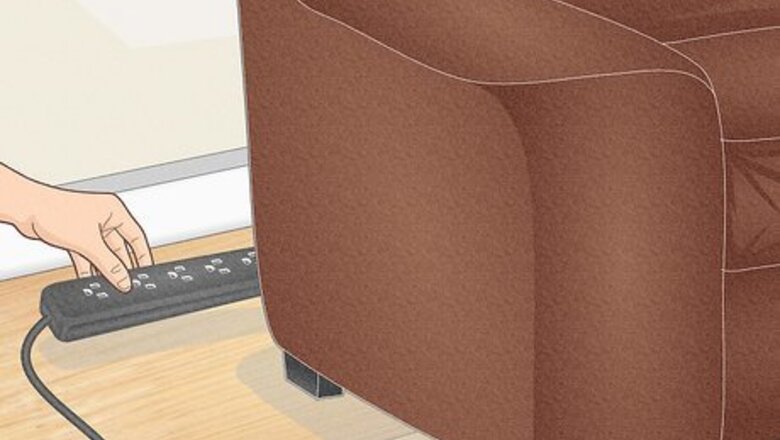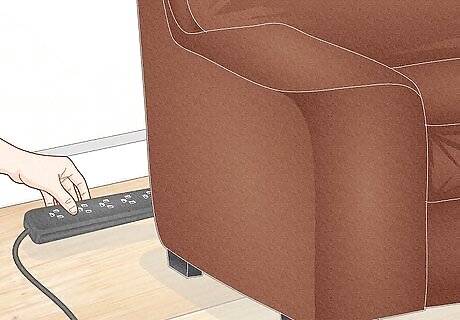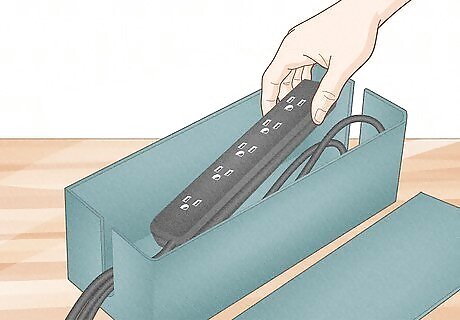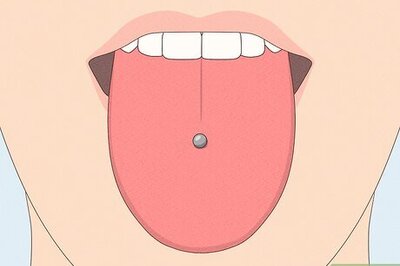
views
Here are 6 different ways you can hide unsightly power strips in your home.
Behind furniture

The easiest way to hide a power strip is to obscure it behind furniture. Set the power strip behind the TV stand, desk, or sofa that it’s next to. Simply slide your furniture out a few inches to give the power strip some space for air flow and keep it from resting directly against any furniture. So long as there’s a bit of room, the power strip won’t be a problem. However, some cords and devices can generate heat, so you don’t want the power strip resting directly against any flammable furniture. Never plug high-voltage devices that produce heat into a power strip. This is especially important if you slide the power strip behind furniture. Items like hair dryers, space heaters, and toasters will cause the power strip to run hot.
With a cable management box

Purchase a cable management box that’s big enough to hold your power strip. These boxes basically look like small, indistinct shoeboxes. They come in plastic or wood, and there all kind of designs out there depending on what you’re looking for. There are openings on the bottom for air flow, so you don’t need to worry about the strip overheating in the box so long as you don’t plug in any high-voltage devices. To use the strip, set the power strip inside of the box and feed the strip’s main cable through the hole on one side. Bundle all of your cords together and run them out together through the other side for a simple, aesthetically-pleasing replacement for that hideous power strip.
In a drawer

If your power strip is near an end table or desk drawer, hide it inside. If there’s a gap between the back of the drawer and the back of the furniture, set the power strip at the back of the drawer and run the cable down along that gap and out the back. If there isn’t a gap, attach a hole saw bit to a drill and punch a few holes through the back of the drawer to feed your cords through. So long as the back of the furniture is facing the wall, nobody should notice the cords running out the back.
Under a desk

Buy a few adhesive command strips and stick them to the back of the power strip. Then, remove the adhesive backing on the other side and stick it to the underside of your desk. This is an especially elegant solution if you have a minimalistic desk with an open back, since you can run the cords attached to the power strip directly behind the desk to easily attach your devices. Ikea sells a cheap cable management tray called the Signum, which is extremely popular for this. It’s basically a hanging tray that attaches underneath your desk, and the power strip just rests on top of it.
On the wall

Look on the back of your power strip to see if there are screw slots. You may have never noticed, but most power strips have screw slots to hang the strip on a wall. Find small screws that match the openings on your power strip. Then, select an indistinct portion of nearby drywall and use a drill to install your screws. Slide the power strip over the screws so that it hangs on them to keep the strip off of the ground. Some power strips have 1 screw slot, while others have 2. If you have 2 slots, measure the distance between each slot and use the same measurement to drill your screws into the wall so they match. Power strips don’t weigh very much, so you shouldn’t need to use any wall anchors or fancy mounting materials.
With a cordless strip

Swap out that old bulky power strip for a version that sits directly on the outlet. These power strips look like a large set of outlets, and they connect directly into the wall. This is a great way to save some space and keep that long power strip from hanging on the floor in front of the outlet. It will still be noticeable at the wall, but you won’t accidentally kick that bulky strip hanging underneath your desk! Don’t use extension cords with this style of power strip.




















Comments
0 comment